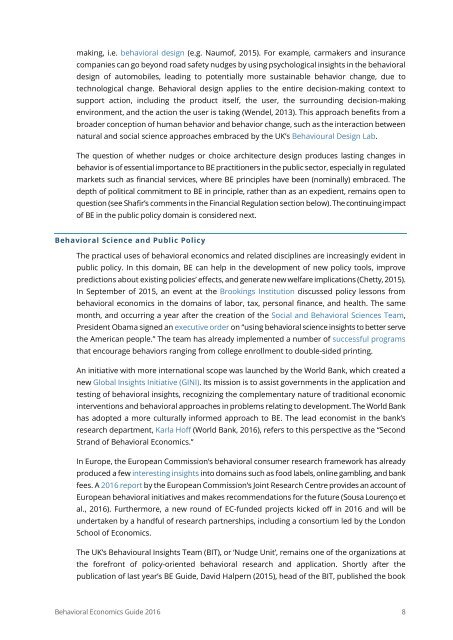THE BEHAVIORAL ECONOMICS GUIDE 2016
BEGuide2016
BEGuide2016
You also want an ePaper? Increase the reach of your titles
YUMPU automatically turns print PDFs into web optimized ePapers that Google loves.
making, i.e. behavioral design (e.g. Naumof, 2015). For example, carmakers and insurance<br />
companies can go beyond road safety nudges by using psychological insights in the behavioral<br />
design of automobiles, leading to potentially more sustainable behavior change, due to<br />
technological change. Behavioral design applies to the entire decision-making context to<br />
support action, including the product itself, the user, the surrounding decision-making<br />
environment, and the action the user is taking (Wendel, 2013). This approach benefits from a<br />
broader conception of human behavior and behavior change, such as the interaction between<br />
natural and social science approaches embraced by the UK’s Behavioural Design Lab.<br />
The question of whether nudges or choice architecture design produces lasting changes in<br />
behavior is of essential importance to BE practitioners in the public sector, especially in regulated<br />
markets such as financial services, where BE principles have been (nominally) embraced. The<br />
depth of political commitment to BE in principle, rather than as an expedient, remains open to<br />
question (see Shafir’s comments in the Financial Regulation section below). The continuing impact<br />
of BE in the public policy domain is considered next.<br />
Behavioral Science and Public Policy<br />
The practical uses of behavioral economics and related disciplines are increasingly evident in<br />
public policy. In this domain, BE can help in the development of new policy tools, improve<br />
predictions about existing policies’ effects, and generate new welfare implications (Chetty, 2015).<br />
In September of 2015, an event at the Brookings Institution discussed policy lessons from<br />
behavioral economics in the domains of labor, tax, personal finance, and health. The same<br />
month, and occurring a year after the creation of the Social and Behavioral Sciences Team,<br />
President Obama signed an executive order on “using behavioral science insights to better serve<br />
the American people.” The team has already implemented a number of successful programs<br />
that encourage behaviors ranging from college enrollment to double-sided printing.<br />
An initiative with more international scope was launched by the World Bank, which created a<br />
new Global Insights Initiative (GINI). Its mission is to assist governments in the application and<br />
testing of behavioral insights, recognizing the complementary nature of traditional economic<br />
interventions and behavioral approaches in problems relating to development. The World Bank<br />
has adopted a more culturally informed approach to BE. The lead economist in the bank’s<br />
research department, Karla Hoff (World Bank, <strong>2016</strong>), refers to this perspective as the “Second<br />
Strand of Behavioral Economics.”<br />
In Europe, the European Commission’s behavioral consumer research framework has already<br />
produced a few interesting insights into domains such as food labels, online gambling, and bank<br />
fees. A <strong>2016</strong> report by the European Commission’s Joint Research Centre provides an account of<br />
European behavioral initiatives and makes recommendations for the future (Sousa Lourenço et<br />
al., <strong>2016</strong>). Furthermore, a new round of EC-funded projects kicked off in <strong>2016</strong> and will be<br />
undertaken by a handful of research partnerships, including a consortium led by the London<br />
School of Economics.<br />
The UK’s Behavioural Insights Team (BIT), or ‘Nudge Unit’, remains one of the organizations at<br />
the forefront of policy-oriented behavioral research and application. Shortly after the<br />
publication of last year’s BE Guide, David Halpern (2015), head of the BIT, published the book<br />
Behavioral Economics Guide <strong>2016</strong> 8


